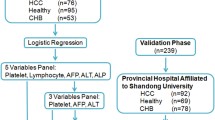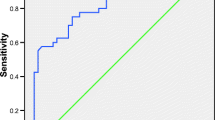Abstract
Conflicting results for circulating glypican-3 (GPC3) were reported in hepatocellular carcinoma (HCC) diagnosis. We aimed to improve the diagnostic power of GPC3 by developing a GPC-HCC model for diagnosing HCC. GPC3 was tested for HCC (138), liver cirrhosis (56), and fibrosis (62) patients by ELISA. Data from patient groups were retrospectively analyzed. A novel score, GPC-HCC, based on combination of GPC3 and routine laboratory tests, was developed for HCC diagnosis. The GPC-HCC model values produced a significant 1.7-fold increase in liver cirrhosis and 3.2-fold increase in HCC, in comparison with liver fibrosis. In contrast to GPC3 and alpha fetoprotein (AFP), the GPC-HCC model showed high HCC diagnostic power with area under the curve (AUC) of 0.939, sensitivity 93 %, specificity 93 %, positive predictive value 89 %, negative predictive value 95 %, and efficiency 93 %. GPC-HCC AUC in HCC with single tumor, absent vascular invasion, and tumor size ≤3 cm were 0.93, 0.92, and 0.92, respectively, compared with 0.63, 0.63, and 0.64, respectively, for GPC3 and 0.69, 0.70, 0.55, respectively, for AFP. In conclusion, owing to these promising findings, the combination of GPC3 with other laboratory simple routine tests (GPC-HCC model) could improve the diagnostic power of GPC3 in HCC screening and follow up of cirrhotic patients.



Similar content being viewed by others
References
El-Serag HB. Hepatocellular carcinoma. N Engl J Med. 2011;365:1118–27.
Kelley RK, Magbanua MJ, Butler TM, et al. Circulating tumor cells in hepatocellular carcinoma: a pilot study of detection, enumeration, and next-generation sequencing in cases and controls. BMC Cancer. 2015;15:206.
El-mezayen HA, Darwish H. Development of a novel score for early detection of hepatocellular carcinoma among high-risk hepatitis C virus patients. Tumour Biol. 2014;35:6501–9.
Shariff MI, Cox IJ, Gomaa AI, et al. Hepato cellular carcinoma: current trends in worldwide epidemiology, risk factors, diagnosis and therapeutics. Expert Rev Gastroenterol Hepatol. 2009;3:353–67.
Mukozu T, Nagai H, Matsui D, Kanekawa T, Sumino Y. Serum VEGF as a tumor marker in patients with HCV-related liver cirrhosis and hepatocellular carcinoma. Anticancer Res. 2013;33:1013–21.
Attallah AM, Omran MM, Attallah AA, et al. HCC-ART score, a simple, highly sensitive and specific test for early diagnosis of hepatocellular carcinoma: a large-scale, multicentre study. Br J Cancer. 2013;109:1657–65.
Filmus J, Shi W, Wong ZM, Wong MJ. Identification of a new membrane-bound heparan sulphate proteoglycan. Biochem J. 1995;311:561–5.
Jia HL, Ye QH, Qin LX, et al. Gene expression profiling reveals potential biomarkers of human hepatocellular carcinoma. Clin Cancer Res. 2007;13:1133–9.
Kandil D, Leiman G, Allegrettaetal M. Glypican-3 immuno-cytochemistry in liver fine-needle aspirates: a novel stain to assist in the differentiation of benign and malignant liver lesions. Cancer. 2007;111:316–22.
Capurro M, Wanless IR, Sherman M, et al. Glypican-3: a novel serum and histochemical marker for hepatocellular carcinoma. Gastroenterology. 2003;125:89–97.
Chen M, Li G, Yanetal J. Reevaluation of glypican-3 as a serological marker for hepatocellular carcinoma. Clin Chim Acta. 2013;423:105–11.
Wang Y, Yang H, Xu H, et al. Golgi protein 73, not Glypican-3, may be a tumor marker complementary to α-fetoprotein for hepatocellular carcinoma diagnosis. J Gastroenterol Hepatol. 2014;29:597–602.
Ozkan H, Erdal H, Kocak, et al. Diagnostic and prognostic role of serum glypican 3 in patients with hepatocellular carcinoma. J Clin Lab Anal. 2011;25:350–3.
Jia X, Gao Y, Zhai D, et al. Assessment of the clinical utility of glypican 3 as a serum marker for the diagnosis of hepatocellular carcinoma. Technol Cancer Res Treat. 2015. doi:10.1177/1533034615605248.
Perkins NJ, Schisterman EF. The inconsistency of ‘optimal’ cut points obtained using two criteria based on the receiver operating characteristics curve. Am J Epidemiol. 2006;163:670–5.
Zakhary NI, Mohamed MS, Khorshid O, Azer RS, Zayed N. Role of glypican-3 in the early diagnosis of hepatocellular carcinoma among Egyptian patients. J Genet Eng Biotechnol. 2012;10:73–9.
Gomaa AI, Hendy OM, Abou Raia GY, et al. The diagnostic value of peripheral blood glypican-3 in patients with hepatocellular carcinoma. World J Med Sci. 2012;7:105–12.
Bruix J, Sherman M. Management of hepatocellular carcinoma. Hepatology. 2005;42:1208–36.
Gish RG. Early detection of hepatocellular carcinoma through surveillance using biomarkers. Gastroenterol Hepatol (N Y). 2014;10:121–3.
Ishizuka M, Kubota K, Kita J, Shimoda M, Kato M, Sawada T. Impact of an inflammation-based prognostic system on patients undergoing surgery for hepatocellular carcinoma: a retrospective study of 398 Japanese patients. Am J Surg. 2012;203:101–6.
Attallah AM, El-Far M, Abdel Malak CA, et al. Evaluation of cytokeratin-1 in the diagnosis of hepatocellular carcinoma. Clin Chim Acta. 2011;412:2310–5.
Nakatsura T, Yoshitake Y, Senju S, et al. Glypican-3, overexpressed specifically in human hepatocellular carcinoma, is a novel tumor marker. Biochem Biophys Res Commun. 2003;306:16–25.
Libbrecht L, Severi T, Cassiman D, et al. Glypican-3 expression distinguishes small hepatocellular carcinomas from cirrhosis, dysplastic nodules, and focal nodular hyperplasia-like nodules. Am J Surg Pathol. 2006;30:1405–11.
Yang SL, Fang X, Huang ZZ, et al. Can serum glypican-3 be a biomarker for effective diagnosis of hepatocellular carcinoma? A meta-analysis of the literature. Dis Markers. 2014;2014:127831.
Liu H, Li P, Zhai Y, et al. Diagnostic value of glypican-3 in serum and liver for primary hepatocellular carcinoma. World J Gastroenterol. 2010;16:4410–5.
Zhao YJ, Ju Q, Li GC. Tumor markers for hepatocellular carcinoma. Mol Clin Oncol. 2013;1:593–8.
Subramaniam S, Kelley RK, Venook AP. A review of hepatocellular carcinoma (HCC) staging systems. Chin Clin Oncol. 2013;2:33.
Toyoda H, Kumada T, Osaki Y, et al. Staging hepatocellular carcinoma by a novel scoring system (BALAD score) based on serum markers. Clin Gastroenterol Hepatol. 2006;4:1528–36.
Tateishi R, Yoshida H, Shiina S, et al. Proposal of a new prognostic model for hepatocellular carcinoma: an analysis of 403 patients. Gut. 2005;54:419–25.
Johnson PJ, Berhane S, Kagebayashi C, et al. Assessment of liver function in patients with hepatocellular carcinoma: a new evidence-based approach-the ALBI grade. J Clin Oncol. 2015;33:550–8.
Patel M, Shariff MI, Ladep NG, et al. Hepatocellular carcinoma: diagnostics and screening. J Eval Clin Pract. 2012;18:335–42.
Hennedige T, Venkatesh SK. Imaging of hepatocellular carcinoma: diagnosis, staging and treatment monitoring. Cancer Imaging. 2013;12:530–47.
Sterling RK, Jeffers L, Gordon F, et al. Utility of Lens culinaris agglutinin-reactive fraction of alpha-fetoprotein and des-gamma-carboxy prothrombin, alone or in combination, as biomarkers for hepatocellular carcinoma. Clin Gastroenterol Hepatol. 2009;7:104–13.
Shen Q, Fan J, Yang XR, et al. Serum DKK1 as a protein biomarker for the diagnosis of hepatocellular carcinoma: a large-scale, multicentre study. Lancet Oncol. 2012;13:817–26.
Shang S, Plymoth A, Ge S, Feng Z, Rosen HR, Sangrajrang S. Identification of osteopontin as a novel marker for early hepatocellular carcinoma. Hepatology (Baltimore, MD). 2012;55:483–90.
Ge T, Shen Q, Wang N, et al. Diagnostic values of alpha-fetoprotein, dickkopf-1, and osteopontin for hepatocellular carcinoma. Med Oncol. 2015;32:59.
Tangkijvanich P, Chanmee T, Komtong S, et al. Diagnostic role of serum glypican-3 in differentiating hepatocellular carcinoma from non-malignant chronic liver disease and other liver cancers. J Gastroenterol Hepatol. 2010;25:129–37.
Acknowledgments
The authors would like to thank the staff of the Biotechnology Research Center, New Damietta, Egypt for their assistance in this study. This work has been completely supported financially and carried out at the Biotechnology Research Center, New Damietta, Egypt.
Author information
Authors and Affiliations
Corresponding author
Ethics declarations
The study protocol was approved by the Institutional Review Committee and conformed to the ethical guidelines of the 1975 Helsinki Declaration.
Conflicts of interest
None.
Rights and permissions
About this article
Cite this article
Attallah, A.M., El-Far, M., Omran, M.M. et al. GPC-HCC model: a combination of glybican-3 with other routine parameters improves the diagnostic efficacy in hepatocellular carcinoma. Tumor Biol. 37, 12571–12577 (2016). https://doi.org/10.1007/s13277-016-5127-6
Received:
Accepted:
Published:
Issue Date:
DOI: https://doi.org/10.1007/s13277-016-5127-6




